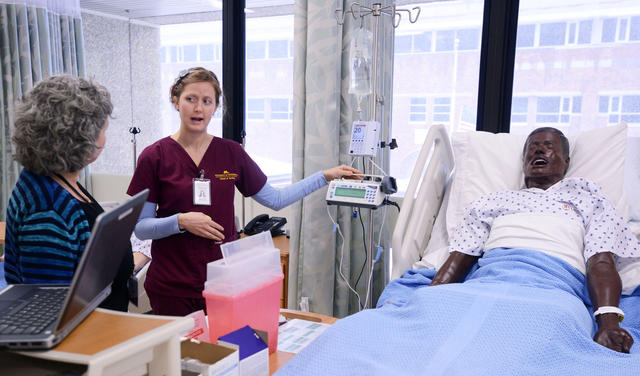Samantha Smith treated a patient with congestive heart failure in a large hospital room Thursday afternoon.
The University of Minnesota nursing senior administered medication on her patient using a syringe pump as a teaching assistant observed.
She was careful to give steady doses at a safe rate to avoid side effects like hearing loss.
But that wasn’t actually a concern — Smith’s patient was a mannequin, and the hospital room was part of the Bentson Healthy Communities Innovation Center, a new educational simulation lab for nursing students that the University School of Nursing showed off at a grand opening event Thursday.
Students can work with new lab equipment in rooms replicating hospital, intensive-care, nursing home, clinical and home-care environments, School of Nursing Dean Connie Delaney said.
The $7.8 million project was privately funded.
Nursing students treat each other as well as mannequins that simulate breathing, heartbeats, wheezing and even bowel sounds, school spokeswoman Barbara Schlaefer said.
Instructors can control how the mannequins respond to the nurses’ treatment and can make them “die” if the students make mistakes, Schlaefer said.
Annette Schwendinger, a family nurse practitioner faculty member, said the simulated environments are important because students learn more in realistic scenarios.
“Being in here is so much more lifelike,” Schwendinger said.
The 11,000-square-foot simulation lab triples the size of the previous lab space, which was more than 25 years old and had outdated equipment, Delaney said.
“It wasn’t in tune with contemporary health delivery,” Delaney said.
For example, nursing students had to raise and lower hospital beds with a crank, although modern beds are operated electronically, said Eunice Areba, a teaching assistant and doctoral candidate.
Marissa Lill, a doctorate of nursing practice student, said the space helps students become comfortable in realistic nursing environments.
“If we can tackle that part of it before we’re actually out in real practice, it’s just one less thing to worry about,” said Lill, who was giving Areba a physical exam after she came in with “lower back pain.”
She then walked into the next room to examine Mrs. Robinson, a patient with a cough and swollen legs — but who was actually a nursing student in a gray wig.
The lab introduces new equipment that nurses will likely see in real working environments, said Sarah Hoffman, a teaching assistant in the skills lab.
The center’s 38 remotely controlled cameras allow students to record themselves working so they can review their performance later, she said.
“You get to practice and make mistakes before anything ever reaches a patient,” Hoffman said.
Nursing students can also work on case studies with students in other health professions, like medical and pharmacy students, Delaney said.
Megan Lifto, a first-year doctorate of nursing practice student, helps teach nursing students how to operate lifting equipment they would use in nursing home environments or on patients with spinal cord injuries.
“It’s a wonderful opportunity for them to practice with the equipment that they’re going to see,” Lifto said.
Molly Huggins, a junior nursing student, spent her afternoon in the intensive care unit treating a mannequin with severe pneumonia.
Huggins said she wishes the lab had opened a year earlier so she could have used it as a sophomore, which is the year students work in lab simulations once a week.
“We’re jealous,” she said.
By Branden Largent
April 22, 2013

